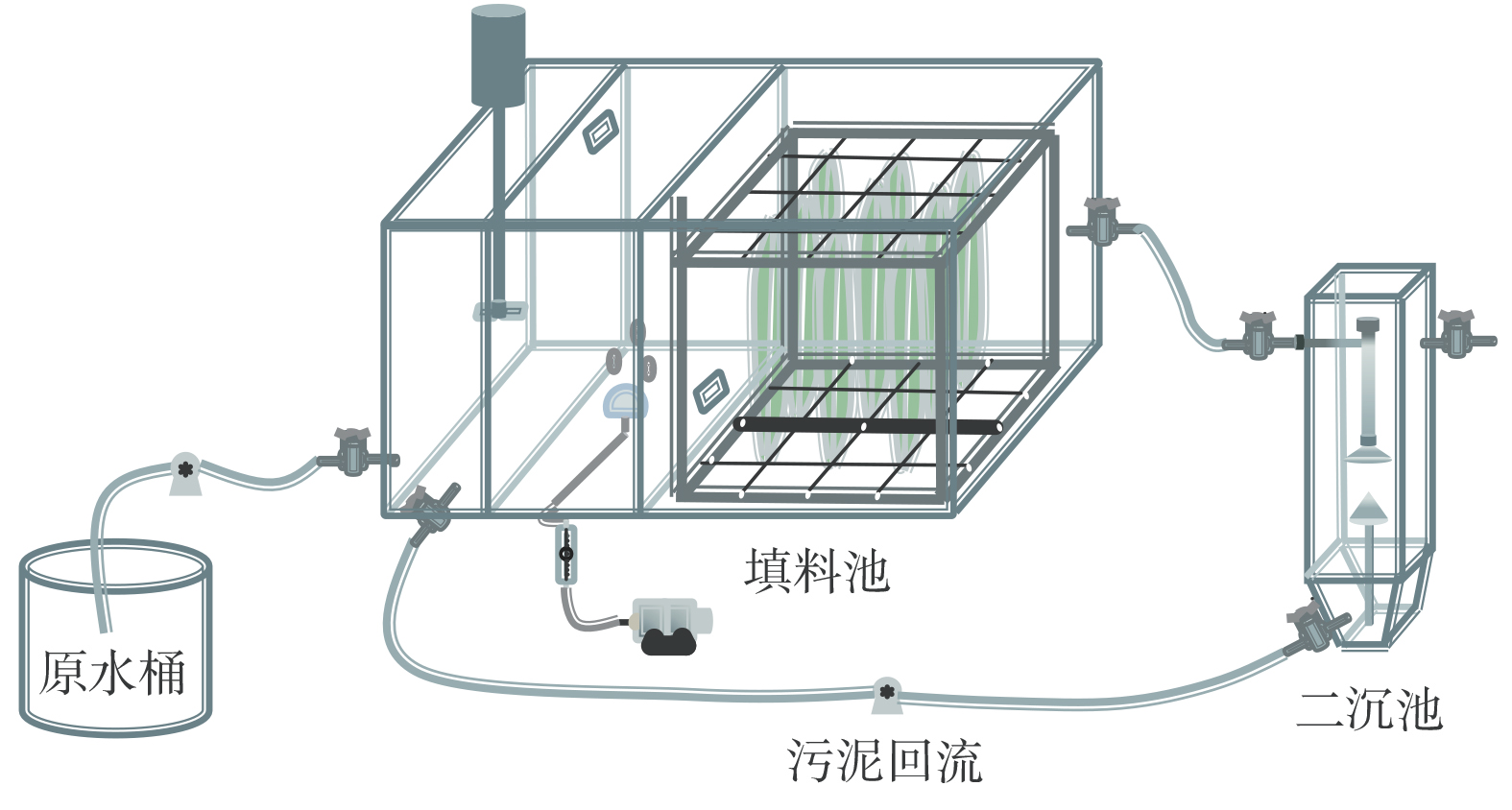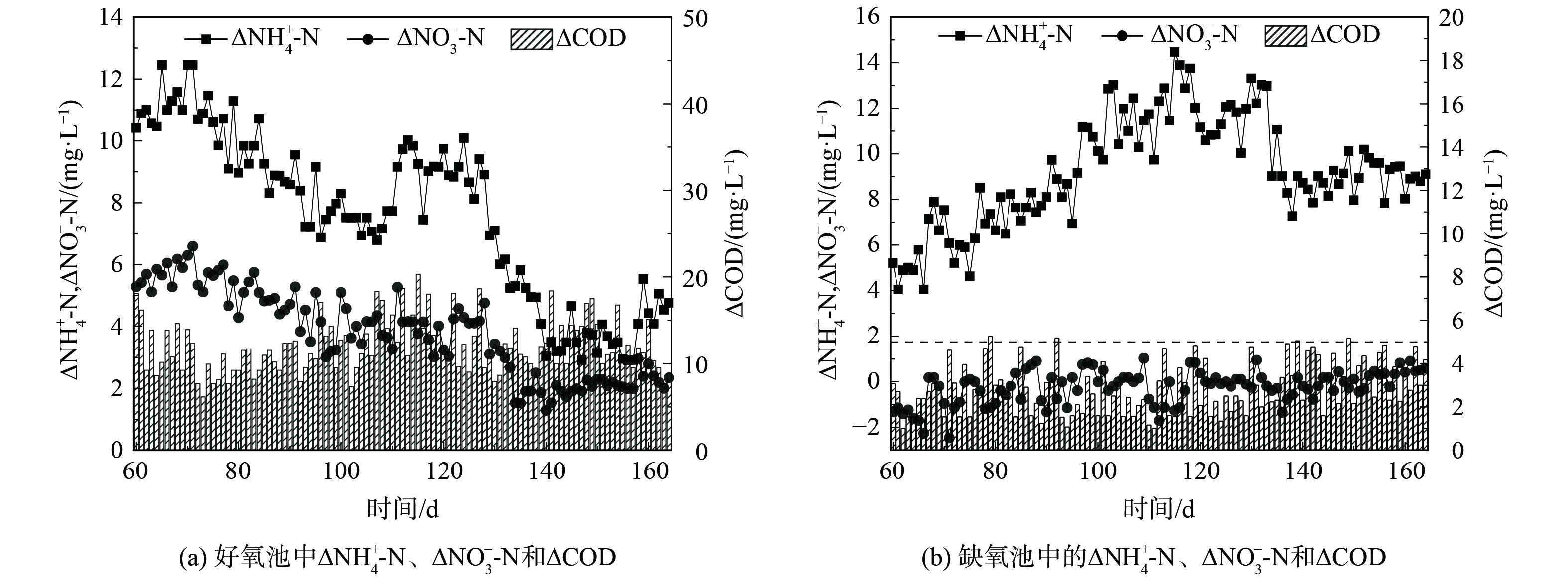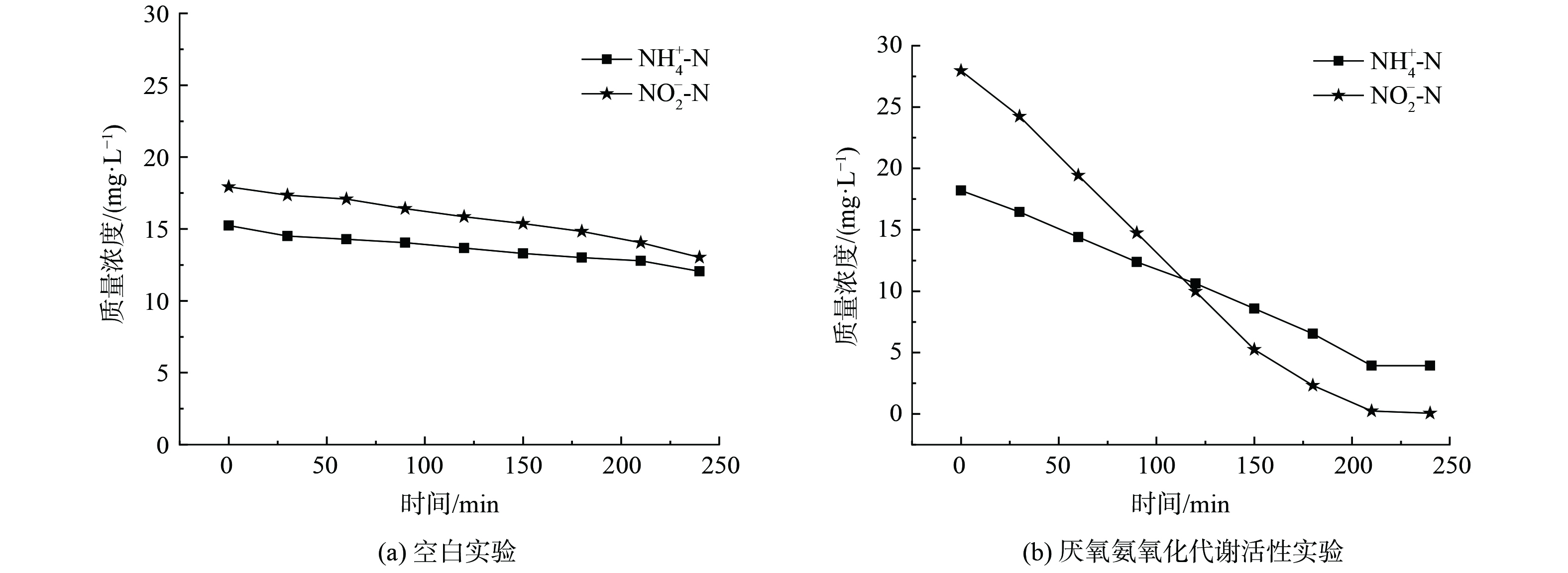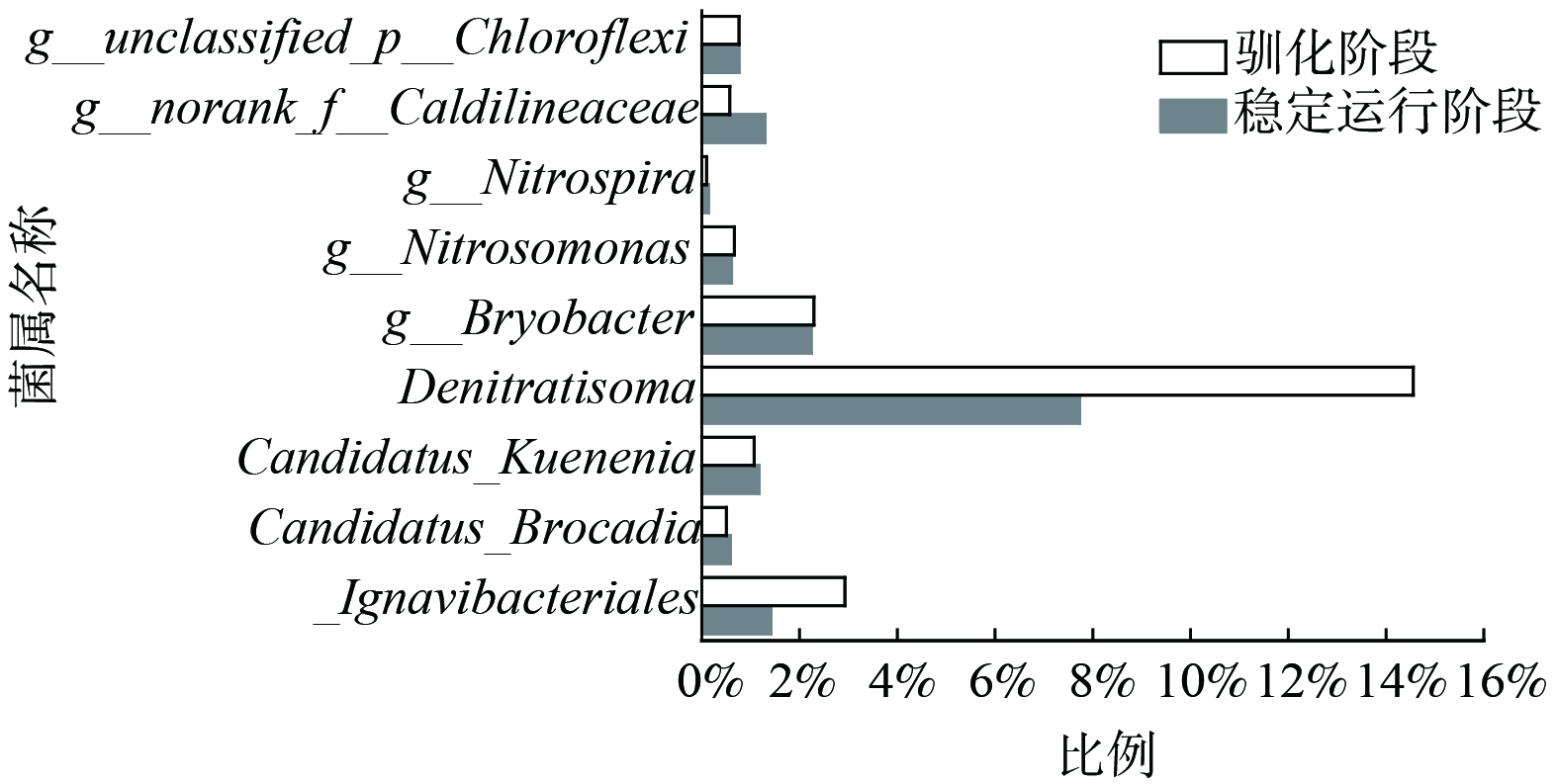-
传统生物脱氮技术具有曝气能耗高、碳源消耗量大、污泥产量高,且易产生温室气体CO2等不足[1] 。随着上世纪90年代厌氧氨氧化(anaerobic ammonium oxidation,anammox)作为新的短流程脱氮途径被证实,基于anammox反应的新型生物脱氮技术迅速成为国内外研究热点[2] 。该反应即在缺氧/无氧条件下,以氨为电子供体,亚硝酸盐为电子受体,产生氮气和少量硝酸盐的生物反应。相比于传统脱氮技术,anammox具有节省60%以上曝气量、节约100%碳源、极大降低污泥产量和减排温室气体等优势[3]。
目前,anammox主要用于污泥消化液和高NH4+-N工业水的处理,在世界范围内已有较多应用案例,其技术经济优势已得到证明[4-5] 。除了污泥消化液和工业废水等侧流处理外,近5年来,已有研究者开始将anammox应用于城市污水主流程的研发[6-7] 。亚硝化(partial nitrification,PN)-anammox (PN-A)工艺可实现污水自养生物脱氮,在城市污水主流程中已有较多研究,可分为单级工艺和两级工艺[8] 。但在城市污水低温和低基质条件下,亚硝酸盐氧化菌(nitrite oxidizing bacteria, NOB)生长速率大于氨氧化菌(ammonia oxidizing bacteria, AOB),污水中游离氨和游离的亚硝酸盐无法有效抑制NOB生长繁殖。因此,AOB很难竞争过NOB,这会导致亚硝酸盐积累不足,较难实现长期稳定的anammox反应,故很难维持其在工程应用中的稳定性和高效性[9-10] 。2013年彭永臻院士团队首次提出短程反硝化(partial denitrification,PD)-anammox(PD-A)工艺。该工艺通过部分反硝化实现相对稳定的亚硝酸盐积累。但短程反硝化反应仍需消耗碳源,增加外碳源来实现PD将增加运行成本。为了将进水中的可生物降解碳源充分应用于PD,彭院士团队也采用“厌氧-好氧-缺氧”模式(AOA)实现内碳源短程反硝化-anammox,其原理是聚糖菌(glycogen accumulating organisms,GAOs)和聚磷菌(phosphorus accumulating organisms,PAOs)在厌氧区能将COD贮存为内碳源,进而在缺氧区发生PD而产生NO2−-N[11] 。但内源反硝化反应速率较慢[12] ,会导致缺氧区的体积增大,且PD相对于PN来说,对曝气量及碳源需求更高。
PN-A和PD-A耦合工艺可将NOB和厌氧氨氧化菌(anaerobic ammonium oxidation bacteria, AnAOB)产生的部分NO3−-N还原成NO2−-N继续进行anammox反应,降低对NOB控制的要求,同时也能充分利用亚硝化节约能耗的特点,可为主流程脱氮提供一种高效、低耗的解决方案。目前,基于PN-A和PD-A耦合工艺的多途径脱氮研究报道较少,本研究以实际市政污水为处理对象,在厌氧-好氧-缺氧推流式反应器的缺氧区植入高性能纤维束填料,以在主流程实现PN-A和PD-A等多途径高效脱氮,依据市政污水进水水质变化,通过优化外回流比、曝气量等运行参数进行污染物负荷的合理分配,从而实现主流程anammox耦合多途径稳定高效脱氮,以期为anammox的工艺优化及工程应用提供参考。
-
反应器主体由有机玻璃制成,有效体积为50 L,各区域的体积比为1:4:6。厌氧池设置搅拌混合,好氧池通过空气泵可连续曝气,缺氧池则在反应器短程硝化驯化启动后增加束状纤维填料(填充比为25%),以截留AnAOB,通过控制曝停比来维持填料表面的生物膜厚度及活性污泥混合。反应装置如图1所示。
反应器共运行164 d,分为3个阶段。阶段I(第1~59天)短程硝化驯化阶段;阶段II(第60~90天)AnAOB驯化阶段;阶段III(第91~164天)稳定运行阶段。阶段I采用提高好氧池曝气量(0.3~0.7 mL·min−1),控制好氧池DO<1.5 mg·L−1,并调节外回流比进行AOB驯化;阶段II通过降低好氧池曝气量(0.7~0.4 mL·min−1),提高缺氧池曝停比(30 s/50 s~30 s/30 s)的方式使得NH4+-N污染物更多由anammox途径去除,进行AnAOB活性驯化;阶段III则为稳定运行阶段,观察反应器应对进水水质波动的稳定性。运行条件如表1所示。
-
进水取自北京市通州区某污水处理厂的进水 (生活污水) 。运行期间进水水质指标为:COD 62~250 mg·L−1、NH4+-N 22~54 mg·L−1、NO2−-N 0~0.8 mg·L−1、NO3−-N 0.6~1.8 mg·L−1、pH 7.4~7.8。
实验运行期间共接种2次污泥。第一次为反应器刚启动时,接种水厂好氧池活性污泥,接种后污泥质量浓度为3 260 mg·L−1;第二次是第59天时,在缺氧区增设束状纤维填料的同时接种AnAOB颗粒污泥,接种量为3 L,原种泥污泥质量浓度为5 862 mg·L−1。
-
常规检测指标(COD、NH4+-N、NO2−-N、NO3−-N、MLSS)均采用国标法。NH4+-N、NO2−-N、NO3−-N的质量浓度总和用总无机氮 (total inorganic nitrogen,TIN) 表示。DO和pH采用Multi 3 630 IDS WTW(德国)测定。每个实验阶段均留存污泥样品,置于-20 ℃环境中冷冻贮存,统一进行高通量测序。AnAOB代谢活性实验方法参考文献[13]进行测定。
-
在反应器运行过程中,NH4+-N、COD、TIN及好氧池亚硝氮积累率(nitrite accumulation ratio,NAR)的变化情况如图2所示。在短程硝化驯化阶段(第1~59天),反应器进水COD和NH4+-N质量浓度分别由120 mg·L−1上升至250 mg·L−1、30 mg·L−1上升至45 mg·L−1。为应对进水负荷增大带来的冲击并强化AOB的活性,提高反应器外回流比和好氧池曝气量,好氧池DO由0.2 mg·L−1提升至1.5 mg·L−1。反应器COD降低了70%~80%,NH4+-N去除率由30%增至80%,好氧池NAR为(60±10)%,这说明NOB活性成功被抑制,这与好氧池低DO控制与反应器缺氧/好氧分区有关。
首先通过控制低DO(0.2 mg·L−1)条件,使得NOB活性受到抑制,NAR较高为65%。然而,同时NH4+-N去除量仅为(3±1) mg·L−1,AOB活性亦受到抑制,在进水负荷不断提高的条件下,短程硝化反应会成为anammox反应的限速步骤[14],需要提高AOB活性。在AOB、NOB活性均受抑制及进水负荷不断升高的条件下,提高污泥回流比有助于增强活性污泥抗冲击负荷能力。同时,基于低DO条件下AOB相较于NOB表现出更佳的氧亲和能力[15],逐步提高好氧池曝气量并维持低DO条件,可有利于AOB优先利用溶解氧,而比NOB增长优势更明显。随着曝气量逐步提高至0.7 mL·min−1,污泥回流比升高至150%,好氧池DO上升至1.5 mg·L−1, NH4+-N去除量上升至(12±1) mg·L−1,AOB活性亦升高。同时,NAR能稳定维持在50%,NOB活性仍受到抑制。本研究将好氧池DO控制为1.5 mg·L−1,这明显高于短程硝化控制DO阈值(0.5~1 mg·L−1),但仍能维持较高NAR。这可能是由于本研究采取厌氧-好氧-缺氧推流式反应器,在后端设置缺氧区能提供瞬时缺氧环境,从而有助于抑制NOB酶活性而对AOB影响不大。同时,在缺氧环境进入好氧环境后,AOB能优于NOB优势增长[16-17]。这与文献[18-19] 报道的较高缺氧时间/好氧时间(T缺氧/T好氧)可促进亚硝酸盐累积一致。因此,本研究中反应器缺氧区与好氧分区体积比为7:4及低DO条件有助于NOB的抑制。在驯化阶段末期,出水COD和NH4+-N质量浓度分别为(38±2) mg·L−1和8 mg·L−1,且AOB有较好的活性,能满足后端AnAOB启动条件。
第II阶段(第60~90天),在缺氧区投加填料并接种AnAOB种泥,通过降低好氧池曝气量,提高缺氧池曝停比进行anammox启动驯化。该阶段反应器进水C/N与上一阶段相同,驯化期间COD稳定降低了80%,NH4+-N去除率则上升至90%,同时TIN去除率上升至70%~80%,出水TIN为(11±2) mg·L−1 ,低于上一阶段出水TIN(17±3) mg·L−1。这可能是反应器接种了AnAOB之后,发生了部分anammox反应,使得在与上一阶段相同C/N条件下,NH4+-N及TIN去除率均上升。然而,驯化期间NAR下降至20%~40%,这可能是由于通过降低好氧池曝气量,提高缺氧池曝停比,维持缺氧池DO为0.3~0.5 mg·L−1,可为缺氧池提供了合适anammox驯化启动条件。在缺氧池中,NH4+-N可被AOB及AnAOB去除,从而提高了NH4+-N去除率,使得缺氧池出水剩余NH4+-N质量浓度小于5 mg·L−1。低剩余NH4+-N质量浓度会减弱AOB与NOB对O2的竞争,以及AnAOB与NOB对NO2−-N的竞争,从而有助于NOB活性的表达[20]。文献[21-22]表明在剩余NH4+-N质量浓度小于5 mg·L−1时,出现了NOB的增长,使得推流式反应器中NAR下降。
第III阶段(第91~164天),为减少好氧池NAR下降带来的不利影响,该阶段通过降低好氧池曝气量,来增加缺氧池中进水NH4+-N质量浓度。结果表明:该阶段好氧池NAR维持在20%~40%,进水C/N由4.5:1降至2:1,NH4+-N去除率>95%,TIN去除率维持在80%~85%,出水TIN小于6 mg·L−1。在传统硝化反硝化脱氮工艺中,该C/N条件下较难实现出水TN达标(一般C/N大于5时,反硝化作用发挥比较明显)[23]。这表明该反应体系的AnAOB在总氮脱除中发挥了重要作用,使得出水TIN较低。这也说明本反应器在应对低C/N废水及NAR下降的情况下,对TIN仍有较稳定地去除,可实现出水TIN小于6 mg·L−1。
-
反应器于第59天接种了AnAOB种泥。由于填料具有良好的吸附作用使得AnAOB在缺氧区富集和停留。为降低NAR下降带来的不利影响,增加AnAOB富集区的进水基质,通过降低好氧池的曝气量、提高缺氧池曝停比的方式进行好氧池/缺氧池NH4+-N去除负荷分配,结果使得缺氧池NH4+-N去除量与好氧池NH4+-N去除绝对量比值由0.5提高至3,结果如图3所示。图2(c)表明,驯化期间(第60~90天)至稳定运行期间(第91~164天)工艺进水C/N不断下降,但出水TIN却由(11±2) mg·L−1降至小于6 mg·L−1,并能维持稳定运行。这可能是由于缺氧池束状纤维填料富集并停留AnAOB,通过增加缺氧池NH4+-N负荷,让更多进水NH4+-N经由anammox途径去除,从而获得在较低C/N的进水基质条件下的高效脱氮。
-
在该反应体系中,NH4+-N主要由好氧池及缺氧池去除。好氧池与缺氧池NH4+-N去除量、NO3−-N生成量及COD降低量如图4所示。
图4(a)表明,好氧池COD去除量维持在(15±5) mg·L−1,可生化性有机物在好氧池中进一步去除,可减弱缺氧池中有机物对AnAOB的影响。在驯化期间不断降低好氧池曝气量,使得好氧池NH4+-N去除量由(12±1) mg·L−1降至(5±1) mg·L−1。同时,NO3−-N生成量由(5±2) mg·L−1降至(2±1) mg·L−1,通过降低好氧池的NH4+-N去除量减弱了NAR下降带来体系中NO3−-N质量浓度升高的影响,使更多的NH4+-N进入缺氧池。实验期间通过调节曝停比将体系中DO维持在0.3~0.5 mg·L−1,缺氧池的NH4+-N去除量由驯化期间(6±2) mg·L−1上升至稳定运行期(13±1) mg·L−1,而缺氧池NO3−-N生成量始终低于0.5 mg·L−1,低于anammox反应生成NO3−-N的理论生成量0.6~1.5 mg·L−1[24]。这说明体系中存在一定反硝化反应[25],但是该反应区∆COD<5 mg·L−1,远低于传统反硝化脱氮所需碳源理论值[23]。因此,在缺氧池中可能存在anammox和反硝化2种脱氮途径。因此,通过优化NH4+-N负荷分配,可提高缺氧池NH4+-N去除量,让更多的NH4+-N经由anammox途径去除,可在更低C/N条件下,减少NO3−-N生成量,从而形成低TIN出水。
-
为分析缺氧池污泥中anammox代谢活性,在稳定运行期取缺氧池污泥进行批次实验,同时取2份等量缺氧池污泥做空白实验。空白实验即分别观察NH4+-N与NO2−-N随时间的变化情况,方法与anammox代谢活性实验相同[13] 。 NH4+-N和NO2−-N随时间变化情况如图5所示。
图5(a)表明NH4+-N与NO2−-N质量浓度在240 min时分别下降了3.2 mg·L−1和4.9 mg·L−1,这可能是由于污泥自身吸附作用导致的。而图5(b)表明NH4+-N与NO2−-N质量浓度均随时间以更快速率下降,在240 min时分别下降14 mg·L−1和28 mg·L−1,其中ΔNO2−-N/ΔNH4+-N=2,高于anammox反应的理论值1.32。这说明体系中anammox具有较高的代谢活性,且同时存在反硝化反应,较直接地证明主流程中anammox在氮去除中发挥的重要作用。
除上述对缺氧池中anammox代谢活性分析外,本实验也对缺氧池中微生物群落结构进行解析。图6为驯化阶段(第78天)和稳定运行阶段(第132天)基于属水平的高通量测序结果。
高通量测序结果表明,被检测到的AnAOB菌属主要为Candidatus Kuenenia和Candidatus Brocadia,这与文献[26]所报道的市政污水主流程工艺中所发现的AnAOB菌属相一致。在驯化阶段及稳定运行阶段中AnAOB菌属的相对丰度分别为1.6%和1.8%,稳定运行阶段该菌属的相对丰度有所上升,这主要得益于增大缺氧池进水NH4+-N负荷的调控手段,使AnAOB可利用的基质增加,从而提高该菌属的相对丰度。这说明在稳定运行阶段,该系统在低C/N条件下仍能实现稳定低TIN出水的主要原因是大部分NH4+-N经由anammox反应去除。
然而,体系中主要的反硝化菌属Denitratisoma的相对丰度由驯化期间的15%下降至稳定运行期间7.7%。这可能是由于缺氧池中COD变化量小于5 mg·L−1(如图4(b)),无法满足反硝化的需求,使得Denitratisoma相对丰度降低。根据Candidatus Kuenenia和Candidatus Brocadia相对丰度升高,Denitratisoma相对丰度降低。这说明AnAOB相对于反硝化菌能优势竞争NO2−-N[27]。而低COD去除量易使反硝化菌还原NO3−-N至NO2−-N阶段,减弱NO2−-N进一步还原[25]。这说明在缺氧池有短程反硝化反应发生[28-29],通过短程反硝化反应产生NO2−-N,被AnAOB优势竞争,最终使得NO3−-N生成量低于PN-A反应的理论值。
另外,Nitrosomonas是被检测到的AOB菌属,Nitrospira是被检测到的NOB菌属。在这2个阶段中,Nitrosomonas相对分度分别为0.67%和0.61%,Nitrospira的相对丰度则分别为0.1%与0.14%,Nitrosomonas相对丰度有所降低,Nitrospira的相对丰度有所升高,这易导致NAR下降。但总体而言,Nitrospira的相对丰度始终低于Nitrosomonas相对丰度,NOB活性仍然受到抑制。这说明体系中可能发生短程硝化作用从而产生NO2−-N。反应体系中缺氧池DO较低(0.3~0.5 mg·L−1),使AOB能优势竞争DO而抑制NOB,为厌氧氨氧化反应提供NO2−-N。
上述结果说明,在缺氧池的DO为0.3~0.5 mg·L−1条件下,Nitrosomonas、Denitratisoma、Candidatus Kuenenia和Candidatus Brocadia等优势菌属得以共存,缺氧池存在anammox以及反硝化等多种脱氮途径,使得NO3−-N生成量较低。
-
1) 反应器中缺氧区和好氧区的体积比为7:4,好氧池DO约1.5 mg·L−1,能实现短程硝化(NAR为50%),同时通过调控缺氧池NH4+-N负荷和低溶解氧条件,DO为0.3~0.5 mg·L−1,可使该工艺在低C/N进水条件下,实现TIN去除率为80%~85%。
2) 在稳定运行阶段,缺氧池∆NH4+-N为(13±1) mg·L−1,∆COD<5 mg·L−1,∆NO3−-N<0.5 mg·L−1。这表明缺氧池存在anammox及反硝化反应,且anammox在主流程工艺中发挥了重要作用。
3) 在缺氧段检测到AnAOB菌属Candidatus Kuenenia和Candidatus Brocadia作为优势种群存在,从微观角度可以证明主流程anammox反应的宏观效能。同时,检测到的反硝化菌属Denitratisoma等进一步表明该工艺中可能存在anammox、短程硝化和反硝化等多种脱氮途径,有利于在低碳氮比条件下实现TIN的深度脱除。
主流程厌氧氨氧化耦合多种脱氮途径处理市政污水
Mainstream anammox coupled with multiple denitrification paths to treat municipal wastewater
-
摘要: 采用厌氧-好氧-缺氧推流反应器,研究实现低碳氮比主流程厌氧氨氧化(anammox)耦合多种脱氮途径的启动条件,并对脱氮途径进行分析。首先进行短程硝化驯化启动,接着在缺氧池投加填料以及接种厌氧氨氧化细菌(AnAOB),进行主流程anammox工艺脱氮。结果表明,好氧池DO约为1.5 mg·L−1时,NH4+-N去除率为80%,亚硝氮积累率为50%,短程硝化驯化启动成功。AnAOB接种启动后,在维持缺氧池DO为0.3~0.5 mg·L−1,缺氧池NH4+-N去除量为好氧池的3倍时,可实现进水C/N为2,出水总无机氮 (TIN) 低于6 mg·L−1,NH4+-N去除率>95%,这表明anammox驯化启动成功。分析缺氧池氮素变化情况表明缺氧池存在anammox及反硝化多种脱氮途径。高通量测序结果可确定Candidatus Kuenenia和Candidatus Brocadia等AnAOB菌属及Denitratisoma(反硝化菌)在缺氧池中显著存在,从微生物种群角度解析了anammox及反硝化等多种脱氮途径,使出水TIN<6 mg·L−1。该工艺可调控主流程anammox耦合多种脱氮途径,为低C/N市政污水深度脱氮提供可行的技术途径。Abstract: In this study, an anaerobic-aerobic-anoxic push-flow reactor was used to study the start-up conditions for realizing mainstream anaerobic ammonia oxidation (anammox) coupled with multiple denitrification pathways with low C/N and to analyze the denitrification pathways. The experiment started with a partial nitrification domestication, followed by filling of the anoxic tank and inoculation with anaerobic ammonia oxidizing bacteria (AnAOB) to achieve denitrification in mainstream anammox process. The results showed that the removal rate of NH4+-N was 80% and the nitrite accumulation ratio was 50% when the DO was about 1.5 mg·L−1 in the aerobic tank. The partial nitrification domestication was started successfully . After the inoculation of AnAOB, the influent C/N was 2, the effluent total inorganic nitrogen (TIN) was less than 6 mg·L−1 and the NH4+-N removal rate was more than 95% when the DO of the anoxic tank was maintained at 0.3~0.5 mg·L−1 and the NH4+-N removal in the anoxic tank was three times that of the aerobic tank, which showed that anammox domestication was successfully started. Analysis of nitrogen variation in the anoxic tank indicated the presence of anammox and multiple denitrification pathway. High-throughput sequencing results determined that AnAOB bacteria such as Candidatus Kuenenia and Candidatus Brocadia and Denitratisoma (denitrifying bacteria) had significant presence in the anoxic tank, which resolved from the perspective of microbial populations that multiple denitrification pathways such as anammox and denitrification existed and made the effluent TIN less than 6 mg·L−1. This process could regulate the mainstream anammox coupled with multiple denitrification pathways, providing a feasible technical approach for deep denitrification of low C/N municipal wastewater.
-
Key words:
- anammox /
- municipal wastewater /
- partial nitrification
-

-
表 1 不同运行阶段实验参数
Table 1. Operating parameters during different experimental periods
阶段 时间/d 好氧池曝气量/(mL·min−1) 缺氧池曝停比 外回流比 I 1~30 0.3 — 100% 31~59 0.7 — 150% II 60~90 0.7~0.4 30 s/(50~30) s 100% III 91~164 0.4~0.3 30 s/30 s 100% -
[1] CHEN Y J, GUO G Z, LI Y Y. A review on upgrading of the anammox-based nitrogen removal processes: Performance, stability, and control strategies[J]. Bioresource Technology, 2022, 364: 127992. doi: 10.1016/j.biortech.2022.127992 [2] ZHANG L, JIANG L, ZHANG J T, et al. Enhancing nitrogen removal through directly integrating anammox into mainstream wastewater treatment: Advantageous, issues and future study[J]. Bioresource Technology, 2022, 362: 127827. doi: 10.1016/j.biortech.2022.127827 [3] CHEN H, WANG H, CHEN R, et al. Unveiling performance stability and its recovery mechanisms of one-stage partial nitritation-anammox process with airlift enhanced micro-granules[J]. Bioresource Technology, 2021, 330: 124961. doi: 10.1016/j.biortech.2021.124961 [4] ZHAO Q, PENG Y, LI J, et al. Sustainable upgrading of biological municipal wastewater treatment based on anammox: From microbial understanding to engineering application[J]. Science of The Total Environment, 2022, 813: 152468. doi: 10.1016/j.scitotenv.2021.152468 [5] LACKNER S, GILBERT E M, VLAEMINCK S E, et al. Full-scale partial nitritation/anammox experiences–an application survey[J]. Water Research, 2014, 55: 292-303. doi: 10.1016/j.watres.2014.02.032 [6] LV Y, PAN J, HUO T, et al. Enhance the treatment of low strength wastewater at low temperature with the coexistence system of AnAOB and heterotrophic bacteria: performance and bacterial community[J]. Science of the Total Environment, 2020, 714: 136799. doi: 10.1016/j.scitotenv.2020.136799 [7] BUNSE P, ORSCHLER L, AGRAWAL S, et al. Membrane aerated biofilm reactors for mainstream partial nitritation/anammox: Experiences using real municipal wastewater[J]. Water Research X, 2020, 9: 100066. doi: 10.1016/j.wroa.2020.100066 [8] 徐峥勇. 基于亚硝化、厌氧氨氧化与反硝化的脱氮耦合工艺及其控制策略研究[D]. 长沙: 湖南大学, 2011. [9] TRINH H P, LEE S H, JEONG G, et al. Recent developments of the mainstream anammox processes: challenges and opportunities[J]. Journal of Environmental Chemical Engineering, 2021, 9(4): 105583. doi: 10.1016/j.jece.2021.105583 [10] GHOLAMI-SHIRI J, AZARI M, DEHGHANI S, et al. A technical review on the adaptability of mainstream partial nitrification and anammox: Substrate management and aeration control in cold weather[J]. Journal of Environmental Chemical Engineering, 2021, 9(6): 106468. doi: 10.1016/j.jece.2021.106468 [11] GAO X J, ZHANG L, PENG Y Z, et al. The successful integration of anammox to enhance the operational stability and nitrogen removal efficiency during municipal wastewater treatment[J]. Chemical Engineering Journal, 2023, 451: 138878. doi: 10.1016/j.cej.2022.138878 [12] GAO X J, ZHANG T, WANG B, et al. Advanced nitrogen removal of low C/N ratio sewage in an anaerobic/aerobic/anoxic process through enhanced post-endogenous denitrification[J]. Chemosphere, 2020, 252: 126624. doi: 10.1016/j.chemosphere.2020.126624 [13] 刘小钗. A2/O短程硝化耦合厌氧氨氧化强化脱氮技术研究[D]. 西安: 西安建筑科技大学, 2020. [14] 姚丽婷, 梁瑜海, 陈漫霞, 等. 高溶解氧条件下不同曝气量对短程硝化性能及微生物特征的影响[J]. 环境科学学报, 2021, 41(8): 3258-3267. doi: 10.13671/j.hjkxxb.2021.0188 [15] 郭凯成, 刘文如, 宋家俊, 等. 短程硝化的影响因素及其耦合工艺的研究进展[J]. 工业水处理, 2022, 42(4): 46-56. [16] 刘文龙. 城市污水主流厌氧氨氧化连续流工艺的脱氮除磷效能研究[D]. 哈尔滨: 哈尔滨工业大学, 2019. [17] ZHANG T, WANG B, LI X Y, et al. Achieving partial nitrification in a continuous post-denitrification reactor treating low C/N sewage[J]. Chemical Engineering Journal, 2018, 335: 330-337. doi: 10.1016/j.cej.2017.09.188 [18] FENG Y, PENG Y Z, WANG B, et al. A continuous plug-flow anaerobic/aerobic/anoxic/aerobic (AOAO) process treating low COD/TIN domestic sewage: Realization of partial nitrification and extremely advanced nitrogen removal[J]. Science of the Total Environment, 2021, 771: 145387. doi: 10.1016/j.scitotenv.2021.145387 [19] GE S J, PENG Y Z, QIU S, et al. Complete nitrogen removal from municipal wastewater via partial nitrification by appropriately alternating anoxic/aerobic conditions in a continuous plug-flow step feed process[J]. Water Research, 2014, 55: 95-105. doi: 10.1016/j.watres.2014.01.058 [20] YANG Y D, ZHANG L, CHENG J, et al. Achieve efficient nitrogen removal from real sewage in a plug-flow integrated fixed-film activated sludge (IFAS) reactor via partial nitritation/anammox pathway[J]. Bioresource technology, 2017, 239: 294-301. doi: 10.1016/j.biortech.2017.05.041 [21] YANG Y D, JIANG Y M, LONG Y N, et al. Insights into the mechanism of the deterioration of mainstream partial nitritation/anammox under low residual ammonium[J]. Journal of Environmental Sciences, 2023, 126: 29-39. doi: 10.1016/j.jes.2022.04.005 [22] MIAO Y Y, ZHANG L, YANG Y D, et al. Start-up of single-stage partial nitrification-anammox process treating low-strength swage and its restoration from nitrate accumulation[J]. Bioresource Technology, 2016, 218: 771-779. doi: 10.1016/j.biortech.2016.06.125 [23] 冯凯. 低C/N污水脱氮固态碳源的研究[D]. 太原: 山西大学, 2020. [24] 王鑫, 穆永杰, 薛晓飞, 等. 不同气源曝气对一段式厌氧氨氧化工艺启动与运行的影响[J]. 环境工程学报, 2021, 15(8): 2778-2788. doi: 10.12030/j.cjee.202103060 [25] 侯朝阳, 贾紫雯, 付静薇, 等. 部分硝化/厌氧氨氧化 (PN/A) 工艺对城市污水厌氧处理单元出水的强化脱氮效果[J]. 环境工程学报, 2022, 16(3): 806-813. [26] ZHU G, WANG S, MA B, et al. Anammox granular sludge in low-ammonium sewage treatment: Not bigger size driving better performance[J]. Water Research, 2018, 142: 147-158. doi: 10.1016/j.watres.2018.05.048 [27] ZHANG W K, YU D S, ZHANG J H, et al. Start-up of mainstream anammox process through inoculating nitrification sludge and anammox biofilm: Shift in nitrogen transformation and microorganisms[J]. Bioresource Technology, 2022, 347: 126728. doi: 10.1016/j.biortech.2022.126728 [28] 张树军, 黄剑明, 马淑勍, 等. 连续流分段进水短程反硝化-厌氧氨氧化耦合工艺的反硝化脱氮特性[J]. 环境工程, 2022, 40(11): 13-18. [29] 薛晶晶, 雷振, 王俊, 等. 一段式短程反硝化耦合厌氧氨氧化工艺处理厌氧膜生物反应器出水[J]. 环境工程学报, 2022, 16(3): 788-797. -




 下载:
下载:






